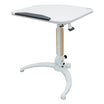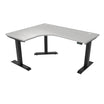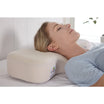Imagine this: You’re in the middle of a task when you feel an itch on your nose. At first, it’s slight, but as you continue to ignore it, the feeling intensifies, as if there were a billion ants crawling over your nose. You try to focus, but you can’t quite do anything without half-assing and rushing it, until you scratch that itch.
This is what it’s like to work in an un-ergonomic office. After an hour sitting in a stifling cubicle where your desk is too high and your chair too rigid, your wrists start to hurt and your back starts to ache. The discomfort becomes so overwhelming that it’s almost physically impossible to do any work adequately. Not to mention, over time, these little aches can turn into long-term strains, contributing to increased workplace absences.
There’s a common misconception that the more comfortable your environment feels, the lazier you’ll get. In a workplace, however, unless your chair has been replaced with a mattress, comfort is an energy booster. Agonising over muscle aches and awkward sitting positions can take a lot out of you, just like how a grimace feels more effortful than a grin.
An ergonomic setting frees your mind up to concentrate on other pressing, profit-making matters. It creates efficiency by way of physical bliss—and happier employees spend 80% of the workweek productively, while sourpusses do actual work only 40% of the time (two out of five days), according to research by iOpener Institute. You could potentially be paying your staff to do nothing for 100 days a year.
Aside from investing in office chairs with better lumbar support, make sure that the height of the tables complements each user. Your elbows should rest by your side at 90 degrees, which prevents your wrist from bending at an awkward angle. Your knees should also be kept at a 90-degree angle.
To keep your glutes from shutting down, make space in the office for movement. If there’s room for standing desks, even better. Computer monitors should be placed an arm’s length away from the eyes as well. Place it too far, and it’ll encourage slouching. Plant it too near, and it’s a one-way ticket to myopia.
While you’re optimising your workplace, why not add larger windows to the list. It’s a proven fact that the deprivation of natural light leads to more fatigue and malaise in the office (see: Future Workplace’s “The Employee Experience” survey), which are both productivity deterrents. So pivotal is this simple element that employees from the survey ranked it as more desirable than perks and facilities such as on-site childcare, cafeterias and gyms. Can you blame them? Sunlight is a fundamental human need.
Office ergonomics also lends itself to the way your workstation is organised. If you can’t see your dashboard, how do you expect to drive? While you may argue that a chaotic desk is a symptom of a creative mind, you’re not going to lose your superpowers if you engage in a mini-purge. Besides, a cluttered space is a cluttered mind, so clear out the junk, store the extras, and leave only the frequently-used essentials on the table.
It also helps to categorise your belongings, and store similar items together. This way, you won’t have to waste time going through three whole cabinets for a stamp and an envelope. With one less thing to think about, you’ll be able to power through the tasks at hand at full throttle. Still, a reconfiguration on a micro scale isn’t enough to maximise productivity.
For companies like Samsung, an overall overhaul is necessary to tackle not just efficiency, but also innovation. What does it take for employees to come up with good ideas? They don’t always come to you at your workstation. Scott Birnbaum, the former vice president of Samsung Electronics, believes that chance encounters between staff members are the key to innovation and enhanced performance. Instead of spacing out for an hour at your desk, you could bounce off ideas with a colleague and solve problems within seconds.
Engagement equates to productivity. That’s why many firms have opted to introduce hot-desks and multipurpose zones, catered to facilitate more interactions. Workplace design that promotes communication and expedites decision-making is therefore crucial. That said, you don’t necessarily have to adopt the open-plan layout.
It works to keep your cubicles private, but your pantry or break room open, spacious and conducive for high-quality interactions. Where you place the water cooler or coffee machine (the informal touchpoints for serendipitous, inter-departmental meetings) can also influence who your employees talk to and the quality of these conversations. The more coffee machines there are, the more divided your office will be. If everyone had to share a single machine, everyone from marketing to accounting will at some point interact with each other.
Before you go give your office a makeover though, know what your goals are first, and what your employees need. Even in ergonomic furniture, there’s no one-size-fits-all solution.
Published on: https://www.hnworth.com/article/2019/06/03/productivity-101-the-importance-of-having-an-ergonomic-office/
This is what it’s like to work in an un-ergonomic office. After an hour sitting in a stifling cubicle where your desk is too high and your chair too rigid, your wrists start to hurt and your back starts to ache. The discomfort becomes so overwhelming that it’s almost physically impossible to do any work adequately. Not to mention, over time, these little aches can turn into long-term strains, contributing to increased workplace absences.
There’s a common misconception that the more comfortable your environment feels, the lazier you’ll get. In a workplace, however, unless your chair has been replaced with a mattress, comfort is an energy booster. Agonising over muscle aches and awkward sitting positions can take a lot out of you, just like how a grimace feels more effortful than a grin.
An ergonomic setting frees your mind up to concentrate on other pressing, profit-making matters. It creates efficiency by way of physical bliss—and happier employees spend 80% of the workweek productively, while sourpusses do actual work only 40% of the time (two out of five days), according to research by iOpener Institute. You could potentially be paying your staff to do nothing for 100 days a year.
Aside from investing in office chairs with better lumbar support, make sure that the height of the tables complements each user. Your elbows should rest by your side at 90 degrees, which prevents your wrist from bending at an awkward angle. Your knees should also be kept at a 90-degree angle.
To keep your glutes from shutting down, make space in the office for movement. If there’s room for standing desks, even better. Computer monitors should be placed an arm’s length away from the eyes as well. Place it too far, and it’ll encourage slouching. Plant it too near, and it’s a one-way ticket to myopia.
While you’re optimising your workplace, why not add larger windows to the list. It’s a proven fact that the deprivation of natural light leads to more fatigue and malaise in the office (see: Future Workplace’s “The Employee Experience” survey), which are both productivity deterrents. So pivotal is this simple element that employees from the survey ranked it as more desirable than perks and facilities such as on-site childcare, cafeterias and gyms. Can you blame them? Sunlight is a fundamental human need.
Office ergonomics also lends itself to the way your workstation is organised. If you can’t see your dashboard, how do you expect to drive? While you may argue that a chaotic desk is a symptom of a creative mind, you’re not going to lose your superpowers if you engage in a mini-purge. Besides, a cluttered space is a cluttered mind, so clear out the junk, store the extras, and leave only the frequently-used essentials on the table.
It also helps to categorise your belongings, and store similar items together. This way, you won’t have to waste time going through three whole cabinets for a stamp and an envelope. With one less thing to think about, you’ll be able to power through the tasks at hand at full throttle. Still, a reconfiguration on a micro scale isn’t enough to maximise productivity.
For companies like Samsung, an overall overhaul is necessary to tackle not just efficiency, but also innovation. What does it take for employees to come up with good ideas? They don’t always come to you at your workstation. Scott Birnbaum, the former vice president of Samsung Electronics, believes that chance encounters between staff members are the key to innovation and enhanced performance. Instead of spacing out for an hour at your desk, you could bounce off ideas with a colleague and solve problems within seconds.
Engagement equates to productivity. That’s why many firms have opted to introduce hot-desks and multipurpose zones, catered to facilitate more interactions. Workplace design that promotes communication and expedites decision-making is therefore crucial. That said, you don’t necessarily have to adopt the open-plan layout.
It works to keep your cubicles private, but your pantry or break room open, spacious and conducive for high-quality interactions. Where you place the water cooler or coffee machine (the informal touchpoints for serendipitous, inter-departmental meetings) can also influence who your employees talk to and the quality of these conversations. The more coffee machines there are, the more divided your office will be. If everyone had to share a single machine, everyone from marketing to accounting will at some point interact with each other.
Before you go give your office a makeover though, know what your goals are first, and what your employees need. Even in ergonomic furniture, there’s no one-size-fits-all solution.
Published on: https://www.hnworth.com/article/2019/06/03/productivity-101-the-importance-of-having-an-ergonomic-office/














![FirstGen™ Ergonomic Kids Study Chair [Colour Options Available]](http://ergoworks.com.my/cdn/shop/files/PK_b1188ee2-f1af-4532-8cf3-f5c356fae74e.webp?v=1748489184&width=104)
![Impact Kids Ergonomic Study Desk And Chair Set [Chair & Length Options Available]](http://ergoworks.com.my/cdn/shop/files/IM-G1000A-GY_IM-YB1108-GY.jpg?v=1740468771&width=104)















发表评论
此站点受 hCaptcha 保护,并且 hCaptcha 隐私政策和服务条款适用。